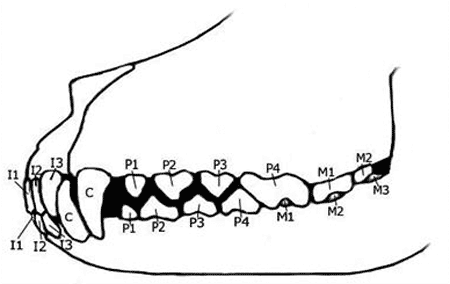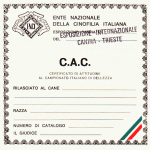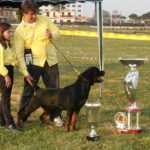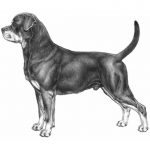I understand that the topic may seem a little 'dry, but since in several breeds dental anomalies I constitute defects from disqualification, it seems appropriate to treat the subject so that it is as easy as possible but interesting.
The dog, as is well known, difiodonte is a mammal that has two successive dentitions,a dairy and other definitive, The milk teeth are present in puppies up to about 4 months and is formed by 28 teeth divided for each semi dental arch in 3 incisors, a dog and 3 molars according to the formula
3 1 3 / 3 1 3 = 14 x 2 = 28
The permanent dentition presents for each semiarcata 3 incisors denominated Picozzo, median and Canton, one canine,4 premolars and 2 upper molars while inferiorly the molars are 3, the dental formula thus proves to be
3 1 4 2 / 3 1 4 3 = 21 x 2
for a total of 42 permanent teeth.
It is very evident that between the milk teeth and the definitive exist 14 Teeth,
these teeth are said monofisari precisely because they have not been preceded by milk teeth; to be precise the monofisari teeth are the first premolar,the first and second molar (lower and upper) and the third lower molar (Arbanassi).
The teeth are constituted by three very hard and resistant substances:ivory, nail varnish, concrete and as many soft parts: pulp, gingival and alveolar periosteum.
E 'soffermasi interesting to observe the shape of the teeth and the admirable wisdom of nature that is able to adapt to all the necessities: incisors, the Solaro describes are planted in dell'intermascellare alveoli (incisive bone) and lower jaws (jaw), their crown is convex to the outer and concave face to the inner face, the free upper edge reminiscent of the flower of lily from which it derives the name of their terminal decoration.
They are generally used by the dog for "odd jobs until" such as females use them to shorten and clean the umbilical cord of the puppies.
The canines are larger incisor teeth their shape is curved cone in anteroposterior direction inside the mouth and are placed between the third incisor and the first premolar.
The upper premolars are four have a triangular shape, the first is extremely small while the fourth is the largest tooth of the upper jaw, fourth premolar has extreme importance in the shredding of food,generally they are used to cut.
The upper molars are two and the Solaro describes them having a triangular shape with rounded corners and the terminal decoration is wide and provided with several tubercles and have to shred function.
The first molar is the largest tooth of the jaw after the fourth premolar.
The lower premolars are very similar to those of the upper jaw,The first molar is the largest of the mandible, the second is much smaller and the third (which present only in the lower jaw) It is still smaller than the second.
There is a substantial difference of points of view with which one can look at a teething: "Old", functional,Pathological .... and the race judge's point of view ! That is, from that point of view that is imposed by the breed standards and the technical guidelines of the original Club.
From this point of view, the toothing of Rott is imperatively described as: full 42 teeth, with upper incisors that are closed scissor above those of the lower jaw.
Indeed appropriately it describes the relationship incisal, while it is essential to the exclusion of subjects suffering from defects in undershot, enognatismo, crossbite and lack of even a single tooth.
Why so hard by the standards with respect to the teeth ?
As first reason is its own point of view of the German cinotecnia he sees in the completeness of the teeth a fairly stiff fee, the exact opposite of the English that much more permissive, but positively pragmatic.
In Rottweiler, German race, to increase the focus on the teeth are witnessing a tragic proportion of subjects with defects of teeth and more, are important because the modifications that undergoes the same with the growth and development of the subject, In short, the gear teeth is a catchphrase that accompanies all his life the breeder of Rott.
A general consideration: the teeth defects are present all over the world and the reality is that although the selection was not reached substantial results, Therefore, because of the breeder teeth wastes time energy and not least money without the desired improvement, on the contrary, I believe it is impractical a herd in which it operates is not a selection.
So what other consideration you may think that the problem can be addressed and possibly solved or at least improved ?
Dr.. Pierluigi Thought, dentist orthodontist, Already a Club advisor suggested about six years ago a theory that may help, the theory was based on the finding that the gap formed by the incisors is not a sufficient index to determine the type of the subject's dentition.
It is obvious that human orthodontics is very advanced and that through the skull radiographs already existing parameters and correct reference points that allow you to correct dental anomalies,in our case it comes to discovering everything from the beginning.
Below will report a study that Dr.. Thought wrote in 1997 precisely in relation to the teeth and more precisely to the type of occlusion, namely the relationship that the individual teeth of the upper jaw have with their counterparts of the lower jaw, aka the dental occlusion.
"In dogs, especially in premolar teeth region must appear well-placed, unlike humans where they must be in contact,at the end of a masticatory function substantially different.
If nature has meant that each arch is fully represented it is necessary that every dental element has a precise relationship with the corresponding elements of the arch antagonist.
If this spatial relationship in the three dimensions of space is correct,we are faced with a perfect scissor bite.
We see in particular those that are the cornerstone of this perfect system reports.
1- the position of the incisors and their relationship, incisive report,normal upper teeth(maxillary) They are slightly earlier than the lower incisors. The incisal edge of the lower,cutting surface,It must be in contact with the surface of the upper incisors watching the palate to the girdle level,where per track is defined as the widest portion incisor. View frontally this closure is characterized by the coverage of the lower incisors,the latter will have to show,even if hidden in part by the upper incisors 2/3 ÷ 3/4 of their buccal surface (the part that looks towards the mouth opening).
2 - The alignment of the incisors is superioni that lower must be assessed in relation to the imaginary line of implantation of the elements on the mandible or jaw
3 - The position of the lower cantons which may be non-aligned with the other incisors move anteriorly and interbreed with the higher homologues
Observed carefully before the closing of our dog, we must now shift our focus laterally to frame:
4 - The position of the canines and their relationship, canine relationship,in general, the lower canines, when the mouth is closed,They must be in a position equidistant between the maxillary lateral incisor,canton, and the upper canine. The ideal occlusion would impose on the lower canine not to lick neither one nor the other of these elements. The relationship we have described is very important and is called "key" canine.
At this point we must observe our dog in profile with his mouth closed, taking care to open his lips. Our focus will once again be to identify the position of the fourth lower premolar.
5 - The highest cusp of the fourth lower premolar is located between the distal surface (rear) III of the upper premolar and the medial surface (front) the fourth upper premolar.
This relationship between the two arches it is necessary to make some clarifications.
The upper jaw is wider than the lower; this arrangement allows the palatal cusps (the part that looks at the palate) the fourth upper premolar to have contact relationship with the lower molar in its component vestibular (the part that looks at the cheek).
6 - The alignment of the premolars and their rotations observed laterally closed bite and subsequently opened
The carnivores attack a large piece of meat or a bone holding the head tilted to one side, because they use their teeth to like a flail.
Of this chopping unit are part of the fourth upper premolar, The upper and the lower molar The molar.
The other premolars have no actual functions,in fact in felids (the most specialized carnivores) they disappeared.
It is clear that to get the maximum effectiveness of this gear must be respected in the positions between the two dental arches, so the bone bases that support will enable effective relationships only if they have a homogenous development.
In a subject undershot the position of the fourth lower premolar it can not be advanced,as well as in a subject it enognato be more rear than the upper arch.
We continue to consider the bite of our dog "ortognato", with scissor, to observe still frontally:
7 - A symmetry of the median line: before looking at the muzzle, will not appear,mouth closed,turning neither to the right nor to the left and opening the lips, maintaining the contact arches the line that separates the two upper central incisors must match with that separating the lower.
At this point only, and only then we can draw our own conclusions.
Merely to assess the correctness of the bite exclusively by observing the front lens group is extremely limiting and often draws in error. The defect must be sought in the global vision of the relationship between the two arches. "
So he ended his article Dr.. Thought it indicated an alternative method and truly innovative way in which to consider the problem of the toothing in the Rottweiler.
I will allow myself an easy joke : If the only result of this new way of looking at the teeth of the Rott will be the owner's ability to have learned "to put your hands in your mouth to your dog without being bitten" is already a success.
In breeder judge quality for years with Dr.. Thought we tried to observe the teeth of our dogs for groped to get used to read in a consistent manner to the method shown here, with the primary purpose of providing useful tips to farmers.
After three years of application Dr.. Thought drew the following considerations:
"Since the method of analysis of the bite that so far no one had suggested, In fact, the analysis was realized in scores that synthesized the correctness or otherwise of the toothing, we should be able to make us understand whether the reporting entity has all the dials in perfect harmony, starting from the axiom that if a group of teeth necessarily move moving contiguous and possibly the sore tooth position is often the alteration skeletal spy.
Practical experience does not seem to confirm this axiom, In fact, we observed individuals with incisive report mediocre and a great back ratio and also opposite conditions. I'm not able to give certainty,but I can only speculate: safe in dogs play a major role in the lateral and posterior, especially mandibular, the interdental spaces for which the teeth depending on the size and direction of eruption may eventually move forward or posteriorly, making autonomous rear keys from the front. "
The which basically means that a subject that presents before a sufficiently correct scissor may present premolars that instead of "correctly wedged between the cusps" (be key) have a 'heads up' report, report that in orthodontics current is defined as "third class malocclusion».
Practically the subject has a gap roughly correct while the side not only lost the correct interdental relations,but above all it has lost part of the cutting function which occurs laterally.
Dr.. Thought is assumed that the critical region could be that of the extremely small P1 and immersed in a sea of space, P2 could move forward at will and keys lost, in this case there would be no skeletal abnormalities, the problem is purely dental and localized in the lateral sector, the anterior region would not affect.
Similarly, a person may have undershot the least in key sectors for a rear light rear migration of dental germs premolar, Therefore, we could be facing an earlier report pincer, while at the rear the key would be perfect.
The median may be influenced by the same factors, for which a non-perfect mating would not be an expression of a mandibular rotation, but it could be the result of a migration of the incisors towards a mandibular emilato.
From the experience acquired, it has therefore thought to shift the focus to the key of the group formed by P4 and upper M1 with M 1 lower, this group of teeth is the engine of chewing and as said Dr.. Thought:
"It is very important that the highest lower cusp M1 goes to touch and engage into the pit that is drawn from the perfect approach between P4 and upper M1, if the relationship between these three teeth is not perfect and the cusp does not go perfectly to fit in its housing creates a most excessive contact part that moves the teeth of the maxilla and mandible. "
It could be the key here explaining many barely covered bites (narrow scissors) and canines that do not engage.
From all this talk you can understand that maybe the initial idea from which we started, and that is that the only observation of closure,as well as to be cleared during exposures,most likely for one who wishes to raise is NOT enough, but it requires a better understanding of the problems of clogging of spawning.
As a result and in order there is a long list of anomalies of dental and occlusive elements of which it is not easy easy to determine a priori what and how much has the genetics or the random component.
As previously reported the incisors may be scissor, but it is essential to understand how deep cover them, especially in relation to age of the subject; it is not uncommon for a person of young age who has a narrow gap especially if male, with the growth and the massive development of the jaws and wear flowers of lilies can in a few months "postponed" at the level bite and then the inverted scissor.
It would also be useful to detect the thickness of the incisors, in some breeds they are now reduced to grains of rice,often the two central incisors are almost united and reduced size so that seem to close pincer with the free edge of the upper incisors.
In reality, then we can see that both the median incisors that the cantons are closed perfectly.
A correct scissor can also be determined by the closure of the four upper central incisors of the lower ones, while the smaller cantons can cross without being fully covered.
Often one can observe a jaw symmetry is not perfect and it is necessary to determine whether this "misalignment" is pathological or random order, Well it is sufficient to observe the way in which the lower canines intersect with the cantons and the upper canines, If the intersection is symmetrical on both right and left the misalignment is not pathological, but if the right canine closes on the canton and the left ends on the canine then the bite is cross.
You may find that in the case where the premolars will obstruct head to head the front scissor does not close, giving rise to an open bite, other abnormalities are those that encounter lower premolars are so key to the higher, but they are in a domestic level to that of their higher homologues.
Finally, it seems fair to say the two main faults whose assessment has to bow down so that the breeder can see all fade ins and dreams subject: undershot and overshot.
These two shortcomings are essentially due to abnormal length of the jaws which are generally ortognate ie the same length.
In prognathism a deficient development of the maxilla determines a scaling of the lower jaw, that if light is described as reverse scissor in this case the ratios of the dental elements are exactly inverted compared to the normal ones, while, If it is serious, the distance between the upper and lower incisors increases until spoiling the aesthetic appearance of the muzzle.
The defect exactly opposite is the enognatismo caused by deficient development of the mandible in practice it is observed that the lower incisors are closed on the palate.
It is considered a serious defect, because it is considered very compatible with life for the containment of language difficulties, the difficult understanding of food.
Sometimes the Rottweiler puppy, one could notice a slight overshot that with the growth often improves until you reach the scissors.
The improvement can be seen by observing the behavior of crossing canines, which after the change of the deciduous teeth that is easy to approach progressively until it reaches a lower canine adjust the position between the upper and Canton.
Although at this point there is still no proper contact between the incisors is very likely that the intersection of the canines functions as a corrective machine as it were "pulling" and bringing the two jaws in the correct proportions.
I realize how tricky matter and not easy to understand, But if some lovers and more specifically some breeder will be able to reap some benefits in improving the selection is already a success.
Carla Romanelli Lensi
Related Posts
NEWS MOST 'INTERESTING
on our blog all the most interesting news about the world of dog world. If you are interested in some information about expo, dog health, breeding Dell'Antico Warrior, you can not find. Contact us we shall be glad to publish some post about it.







